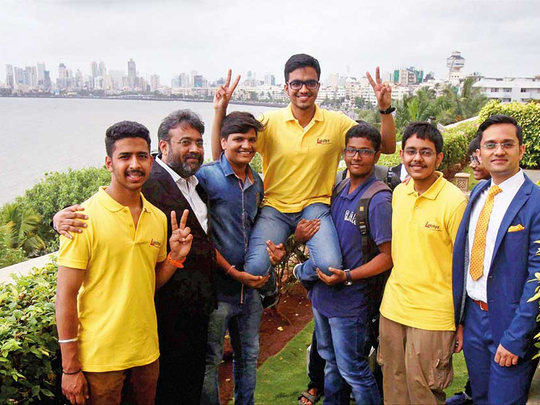
New Delhi: Rohit Choubey’s sole obsession is to gain admission into an Indian Institute of Technology (IIT).
“I feel a lot of pressure. But considering the avenues it opens, I am ready to take the stress and am handling it well,” said the 17-year-old, preparing for the IIT-JEE (Joint Entrance Examination Advanced) entrance exams.
His father, Mohan Choubey, a government schoolteacher, is equally excited.
Providing a glimpse of the aspirations parents in India have for their children, he says, “I want my son to succeed and become a research scientist.
Read more:
History of Indian Institute of Technology
He hopes to join an organisation like the Indian Space Research Organisation someday and we know that only an IIT can fulfil this dream.”
Bill Gates, founder of technology giant Microsoft, is on record as saying, more than a decade ago, “IIT is a world treasure.”.
Proudly declaring that he had two IIT alumni at the vice-president level in his company, the Microsoft chief had described IIT as a “world-class institute.”
But the world is only now beginning to acknowledge this fact.
And it won’t be long before IIT ranks on a par with top institutions such as the Massachusetts Institute of Technology, UC Berkeley and Stanford.
Tech wizards
From famous scientists to top-notch CEOs, IITians are inspiring generations and brand IIT is commanding respect for its quality education.
Recently, IITs ranked fourth for educating students who went to create billion-dollar start-ups, in a report published by a UK-based accounting software firm.
The institutes produce an annual crop of tech wizards and corporate titans, who are either working with or running several top companies around the world.
Prominent among them are: Sundar Pichai, senior vice-president at Google, Sachin Bansal, co-founder of Flipkart, Narayan Murthy, ex-chairman of Infosys, Pranay Chulet, co-founder of Quicker, Bhavish Aggarwal, co-founder of Ola cabs, Deepinder Goyal of Zomato and Nikesh Arora, CEO, Soft Bank.
Even though, by making a mark in almost every profession the Indian ‘techies’ are a common sight today, many of them faced struggles to reach the hallowed precincts.
Success stories
For every Nandan Nilekani or Raghuram Rajan (both from elite backgrounds) there is an Anup or Vatsalya, who have created unthinkable success stories.
Explains Mumbai-based Anup Raaj, 25, who, along with friends, founded PSTakeCare, a health care start-up.
“I feel my journey has finally begun,” says the IIT-Bombay alumnus, gearing to serve the Gulf region in the months to follow.
For a boy who, in 2002, was enrolled into a school at the age of 10, this can be termed incredible.
Raaj belongs to a small village called Chenw, in Aurangabad district of Bihar, and lived in a joint family of 22 members.
He funded his own education by tutoring students and joining a college in Gaya, 40km away from his village.
A free IIT-JEE coaching by Anand Kumar in Patna, Bihar changed his life.
(An educationist, Kumar is known for his Super 30 programme, wherein he coaches economically backward students for IIT entrance examinations).
“I opted to study civil engineering at IIT-Bombay because I wanted to settle in Mumbai and become an entrepreneur,” Raaj explains. Taking education loan was the first step and buying a laptop the next. Even though the first year was extremely difficult due to lectures in English, as Raaj had been a Hindi-medium student, soon he overcame that, “by always carrying a dictionary.” In his third year, he travelled to Dubai for two months for a summer internship.
On passing out from IIT in 2014, he got placed as an associate software engineer at Quickr on a monthly salary of Rs. 100,000. “Back in my village, my grandfather could not believe it. I invited him and my mother to Mumbai and showed my bank passbook to convince them I was doing well,” he laughs.
The per semester cost of studying at an IIT is approximately Rs. 50,000, totalling to around Rs. 400,000 for the 4-year term.
“Looking back, I can say that entrance exams for IIT are probably the most rigorous in the world with over 1.2 million students appearing for barely 11,000 seats. The questions are not just about providing answers. They test your level of thinking out-of-the-box. Students coming from sound financial background certainly have leverage over people like us, but it is no exaggeration that life takes a complete U-turn on becoming an IITian. People’s attitude towards you changes and they look up to you with respect,” 22-year-old Raaj adds.
Welder's son
Chandra Kant Singh Chauhan, a welder, who earned a living by repairing metal gates and grilles, would agree wholeheartedly. He had not known anyone who attended IIT, but he knew that if his son Vatsalya Chauhan made it to the institute, it would change his family’s fortunes forever. Vatsalya cleared the exams with an all-India rank of 382 in 2012. Thereafter, he enrolled in Bachelor of Technology, Computer Science at IIT-Kharagpur.
“My father had taken a loan amount of Rs350,000 to fund my studies. There was no question of failing him. Today, he proudly tells everyone that his son is working at Microsoft in Vancouver, Canada, earning Rs. 1.2 million a month,” he informs.
Relating his experience, Chauhan said, “I was exposed to a plethora of opportunities to showcase myself to the world and also learnt a lot. Only a brand like IIT can provide such exposure. I had cracked the exams in the second attempt. Rank matters a lot here, as branch allocation is based on ranking. For instance: to get computer science in one of the top IITs, one must rank under 400-500, though it varies each year. In addition, there are scholarships like ‘merit-cum-means’ that make things easier for students from the lower strata of society. Based on a student’s performance and the yearly income of his/her parents, the scholarship covers the entire tuition fee.”












